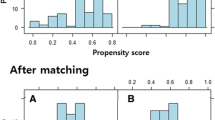Abstract
In pulmonary surgery, methicillin-resistant Staphylococcus aureus (MRSA)-positive patients present an issue of perioperative antimicrobials. During 1996 to 2009 in a total of 1,080 pulmonary operations, MRSA was detected before 20 operations. Perioperatively, we followed the Sanford Guide using vancomycin (VCM) or arbekacin (ABK) in MRSA-positive cases at high risk (n = 14), including 1 with clinical infection and 13 with colonization. We used 1-day cefazolin (CEZ) in MRSApositive cases at low risk (n = 6). We defined the outcome as surgical site infection (SSI) that included death from infection. The 14 high-risk cases received a median of 3 days of VCM or ABK, of which 1 (7%) developed SSI. Of the cases given CEZ, we noted SSI in 1 of 6 low-risk cases (17%). Thus, MRSA-positive pulmonary surgery patients at large may receive 3-day VCM or ABK.
Similar content being viewed by others
References
Gilbert DN, Moellering RCJr, Eliopoulos GM, Chambers HF, Saag MS. The Sanford guide to antimicrobial therapy 2009, 39th edition. Sperryville, VA: Antimicrobial Therapy, Inc.; 2009. p. 169.
Japanese Society for Infection Diseases, Japanese Society for Chemotherapy. Guideline for antimicrobial use. Tokyo: Kyowa-kikaku; 2005. p. 163–164.
Mangram AJ, Horan TC, Pearson ML, Silver LC, Jarvis WR, The Hospital Infection Control Practices Advisory Committee. Guideline for prevention of surgical site infection. Infect Control Hosp Epidemiol 1999;20:247–278.
Kusachi S, Sumiyama Y, Nagao J, Arima Y, Yoshida Y, Tanaka H, et al. Prophylactic antibiotics given within 24 hours of surgery, compared with antibiotics given for 72 hours perioperatively, increased the rate of methicillin-resistant Staphylococcus aureus isolated from surgical site infections. J Infect Chemother 2008;14:44–50.
Tacconelli E, Cataldo MA, Albanese A, Tumbarello M, Arduini E, Spanu T, et al. Vancomycin versus cefazolin prophylaxis for cerebrospinal shunt placement in a hospital with a high prevalence of methicillin-resistant Staphylococcus aureus. J Hosp Infect 2008;69:337–344.
Harbarth S, Fankhauser C, Schrenzel J, Christenson J, Gervaz P, Bandiera-Clerc C, et al. Universal screening for methicillinresistant Staphylococcus aureus at hospital admission and nosocomial infection in surgical patients. JAMA 2008;299:1149–1157.
Trautmann M, Stecher J, Hemmer W, Luz K, Panknin HT. Intranasal mupirocin prophylaxis in elective surgery. A review of published studies. Chemotherapy 2008;54:9–16.
Pofahl WE, Goettler CE, Ramsey KM, Cochran MK, Nobles DL, Rotondo MF. Active surveillance screening of MRSA and eradication of the carrier state decreases surgical-site infections caused by MRSA. J Am Coll Surg 2009;208:981–986.
Author information
Authors and Affiliations
Corresponding author
Rights and permissions
About this article
Cite this article
Yoshida, J., Furugaki, K. & Oyama, M. Perioperative antimicrobials in chest surgery patients positive for methicillin-resistant Staphylococcus aureus . Gen Thorac Cardiovasc Surg 58, 657–659 (2010). https://doi.org/10.1007/s11748-009-0582-2
Received:
Accepted:
Published:
Issue Date:
DOI: https://doi.org/10.1007/s11748-009-0582-2




